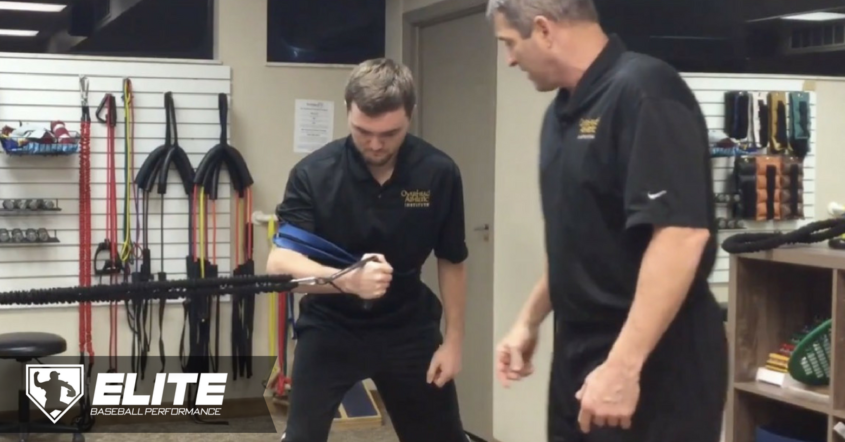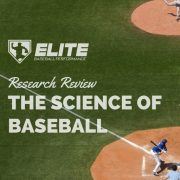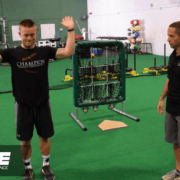2 Key Subscapularis Arm Care Exercises for Baseball Players
The subscapularis is a muscle that is often neglected when talking about arm care exercises for baseball players.
The subscapularis is a rotator cuff muscle that attaches from the inside of your shoulder blade/scapula and wraps underneath to the front part of your shoulder. It can be placed at a mechanical disadvantage with poor mechanics.
It contracts to protect your shoulder from excessive external rotation (layback) late in the throwing motion. There are also larger muscles that contribute to the velocity of the throw that are involved to provide stability (pectoralis major and the latissimus dorsi) in this layback position.
If the shoulder isn’t trained specific to the movement pattern, type of contraction, and position the arm needs to be in to accept these forces, you’re leaving yourself open to injury.
I often see exercises done by throwing athletes with bands or tubing that are nonspecific and do not prepare the shoulder for the forces that are placed on it during maximal external rotation.
Performing any tubing or band exercise does have a potentially positive effect for any throwing athlete, but there are simple things and pivotal positions that athletes should include that can make exercises for the rotator cuff so much better.
The rotator cuff’s primary role is to keep the humerus centered in the socket, resist distraction, and contribute to the ligamentous stability of the glenohumeral joint to prevent excessive anterior and posterior translation of the humeral head.
If the shoulder moves too much in the socket during the throwing motion in either direction that can contribute to instability and injury.
Knowing what a muscle’s role is in the throwing motion and what types of contractions it goes through should be the guiding principle in which exercises are chosen and how they’re performed. There is an extremely delicate balance that must be maintained when training a rotator cuff.
These factors are often overlooked and not included in most arm care routines and training regimens, even in professional baseball. My personal experience in professional baseball with injury, anterior subluxation requiring surgical correction, incomplete recovery, and 17 years of clinical experience working with throwing athletes has forced me to evaluate the effectiveness of rotator cuff exercises.
The posterior rotator cuff is often the prominent focus of in therapy for shoulder athletes, and rightfully so. But the subscapularis is a pivotal muscle for the throwing athlete but it is often neglected in therapy and training situations.
Below are two joint and contraction specific subscapularis exercises that we utilize and often include in our throwers’ corrective exercise programs. These videos give great detail as to the “why” behind certain exercises are chosen.
If you want to have a long-playing career, or even a healthy throwing season, you should implement these 2 exercises into your arm care routine and be sure to focus on your subscapularis.
Ed Martel
Latest posts by Ed Martel (see all)
- 2 Key Subscapularis Arm Care Exercises for Baseball Players - May 22, 2018










Love the thought process behind these exercises to better isolate the subscap and prevent compensation. Wondering if there is any EMG research out there to further support the modifications similar to how there was an increase in infraspinatus activity with a towel being placed under the elbow in resisted ER.
Hi Jake, right now there is no EMG research, but that would be a good idea to look into!
My concern is the exercises are focused on trying to isolate a muscle and not training a movement pattern. Our bodies don’t know muscles they know patterns. If you are setting up artificial conditions that don’t relate to the pattern that is involved you are training a different pattern. We adapt to the specific stimulus that is applied. If the athlete cannot maintain joint position during an exercise that would be closer to the actual movement pattern that we want the strength, actually more likely activation or the correct sequence of activation, the they won’t get it by modifying the exercise. The first step would be to coach the movement pattern and be more specific about the importance of correct body position and execution of the movement. If the athlete is unable to perform the movement perhaps there is an underlying issue and additional assessment is needed. Then a more effective corrective exercise strategy can be developed and implemented.
Hi Jeff, I would say yes and no. If a specific muscle is weak, I still personally believe in isolated strengthening, but then reinforcing a movement pattern. In my practice, i’ve seen too many big athletes with great movement patterns have weak stabilizing muscles. I think everything you said is right, I would just do both!
Hello. My son is 16 and is a 6.6 RHP and weighs 170 pounds. He gets pain in his subscap when he throws at layback. He has never had pain in his arm before or shoulder and can pitch and throw without pain unless he try’s to get early or increased layback by having his arm inside 90 at foot strike. It’s a pinching feeling that happens at the bottom point under his right scap. Any thoughts or recommendations before trying to strengthen?